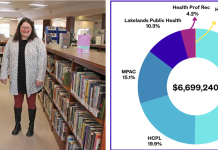Haliburtonian Abe Churko said he got a close experience with youth drug abuse locally at a friend’s birthday party.
He said everyone except him took a bit of “molly” – a slang term for a type of ecstasy. Although he went to sleep at 2 a.m., he awoke four hours later to discover his friends still dancing. The party had not stopped.
“At the time, I found it pretty funny,” Churko said. “But you look back, definitely not healthy for you. The thing is, even with hard drugs, if you do them sometimes (occasionally), it can be sustainable. Some people, they try for a few times and they’re gone off the deep end.”
Across Canada, illicit drug use is more prevalent among youth. The 2017 Canadian Tobacco, Alcohol and Drugs Survey found a higher proportion of youth reported experiencing harm due to their illicit drug use – five per cent of youth aged 15-19 and 10 per cent of young adults aged 20 to 24 – than their counterparts 25 and older (three per cent). The same study found cannabis use more prevalent among youth ages 15-19 (19 per cent) and 20-24 (33 per cent) than adults 25 or older.
Nurse practitioner Kelsey Young previously worked part-time at the Haliburton County Youth Hub as a counsellor. She said it is hard to gauge the state of youth drug use in the area – there are not local hard stats for it – but it is part of the substance abuse picture. Especially for cannabis
“I would say one of the major things specifically within the community would be cannabis,” Young said. “Cannabis is known to be harmful for developing brains. So, the fact that it’s legalized isn’t necessarily a bad thing from a systemic view but it has increased our youth rate in cannabis use.”
Churko said cannabis use is prevalent locally – even before legalization came – though the drug still remains illegal for people under 18.
“A lot of kids start smoking pretty early, and lately, over the past few years, some kids are starting to do hard drugs,” Churko said. “I would say most kids have tried weed at least by the end of high school.”
Young said youth drug use is a complicated issue and there are four primary reasons they do it: to feel good, to cope, to do better at a task, or curiosity, when surrounded by other people using it.
Churko said he has seen drug use emerge in social situations like parties before the pandemic. He said ecstasy gained popularity locally after it emerged at one party, and cocaine has always been around the community.
“People start because they see older people doing it and they either want to be cool or they heard about it so much, they want to feel what it feels like,” he said, adding drugs like weed can help people cope with bad home situations.
He further said there is not much awareness of youth drug use in the community.
“I feel like it’s happening under everyone’s noses,” Churko said. “Everyone just sees doing drugs the same as drinking alcohol. It just starts so early they just see it as the same thing.”
Vaping at issue
Haliburton, Kawartha, Pine Ridge District Health Unit tobacco control officer, Lorne Jordan, said there is another drug that is a significant problem amongst local youth: vaping.
Jordan called it an “epidemic” in local high schools in October 2019, after he had doled out more than 40 charges with fines around the time. He said they made significant progress in education after that, but the pandemic curtailed those efforts.
“COVID just sucks all the oxygen out of the room. Made it impossible to carry that message forward,” Jordan said. “It’s not like the problem went away.”
Jordan said he has had fewer vaping complaints to address from schools since they re-opened in September. Still, he said COVID restrictions may be impacting those totals.
“I don’t think it’s indicative of the fact less students are vaping,” Jordan said. “Hopefully, people will start to come back to it and understand it’s not a consequence-free behaviour.”
Vaping has several short-term health risks and unknown long-term risks. Jordan and others in the public health sectors have called for more restrictions. The province implemented some July 2, limiting most vape products to specialty stores which are restricted to ages 19 and older.
Jordan said those rule changes are positive but do not go far enough.
“We had a very tough act that was watered down by the Ontario government when they took office,” Jordan said. “They listened a little too carefully to the vape lobby and not enough to the science.”
Addressing the problems
Young said it is important the community recognizes the risk of drug use and that places like the youth hub can go a long way to addressing the issue.
“It allows us to provide some preventative care for substance use,” Young said. “Provide information, provide counselling … Providing recreation spaces in order to allow for youth to engage in activities that don’t involve illicit substance use.”
She added for those youth coping with bad home situations, the youth hub also has resources to help address some of that instability.
Churko said better education is important, versus youth receiving charges or criminal punishments for use.
“If you charge someone like that, they’re not going to learn their lesson. They’re just going to get more mad at the system,” Churko said. “Educating parents, probably. Letting them see the warning signs. What these drugs looks like and what your kid would look like.”
Young said harm reduction is also crucial, as well as not stigmatizing users.
“Ostracizing and judging them is not the way to get them the help that they need. In fact, it can often have the opposite effect,” Young said. “Open and honest conversations with youth so that they’re involved. It’s not coming from a ‘we-know-better-than-you perspective.’”





